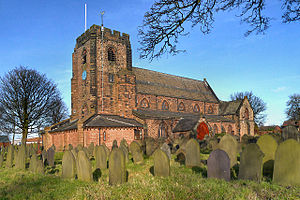The Lancashire Portal

Lancashire (/ˈlæŋkəʃər/ LAN-kə-shər, /-ʃɪər/ -sheer; abbreviated Lancs) is a ceremonial county in North West England. It is bordered by Cumbria to the north, North Yorkshire and West Yorkshire to the east, Greater Manchester and Merseyside to the south, and the Irish Sea to the west.
The county has an area of 3,079 square kilometres (1,189 sq mi) and a population of 1,490,300. After Blackpool (149,070), the largest settlements are Blackburn (124,995) and the city of Preston (94,490); the city of Lancaster has a population of 52,655. For local government purposes, Lancashire comprises a non-metropolitan county, with twelve districts, and two unitary authority areas, Blackburn with Darwen and Blackpool. The county historically included northern Greater Manchester and Merseyside, the Furness and Cartmel peninsulas of Cumbria, and some of northern Cheshire, and excluded the eastern part of the Forest of Bowland. (Full article...)
Selected article -

Sharpe and Paley was a partnership of two architects who practised from an office in Lancaster, Lancashire, England, between 1845 and 1856. Founded by Edmund Sharpe in 1835, the practice flourished for more than a century, until 1946. It had grown to become the largest in northwest England by the late 19th century and was responsible for the design of many important buildings, especially churches. In 1838 Sharpe took as his pupil the 15-year-old Edward Graham Paley, usually known as E. G. Paley. The two formed a partnership in 1845, following which Sharpe took an increasing interest in activities outside the practice. By 1847 Paley was responsible for most of the firm's work, and was carrying out commissions independently from at least 1849. Sharpe formally withdrew from the practice in 1851, although it continued to trade as Sharpe and Paley until 1856.
During Sharpe's time as sole principal the practice was involved mainly with ecclesiastical work, although it also undertook commissions for country houses and smaller projects. The type of work undertaken by the Sharpe and Paley partnership continued much as before, mostly on churches: designing new churches, repairing, rebuilding, and making additions and alterations to existing ones. Many of the alterations to medieval churches were done in the course of restoration work, in an effort to return the structure to its main style, or to what the architect considered to have been the best medieval style, usually that of the 13th and 14th centuries. New churches designed during the partnership include St Nicholas, Wrea Green and Christ Church, Bacup. Work on existing churches included rebuilding most of All Saints, Wigan, and restoring St Oswald, Warton. Most of the practice's ecclesiastical work was for the Church of England, but Sharpe and Paley also designed a new Roman Catholic church, St Mary, Yealand Conyers. (Full article...)Topics
Related portals
Recognised content
Featured Articles:
![]() Blackburn Olympic F.C.,
Blackburn Olympic F.C., ![]() Pendle witches,
Pendle witches, ![]() Samlesbury witches
Samlesbury witches
Featured Lists:
![]() List of Nelson F.C. seasons,
List of Nelson F.C. seasons, ![]() Listed buildings in Rivington
Listed buildings in Rivington
Good Articles:
![]() 1920–21 Burnley F.C. season,
1920–21 Burnley F.C. season, ![]() 1922–23 Nelson F.C. season,
1922–23 Nelson F.C. season, ![]() East Lancashire Railway 1844–1859,
East Lancashire Railway 1844–1859, ![]() Henry of Grosmont, 1st Duke of Lancaster,
Henry of Grosmont, 1st Duke of Lancaster, ![]() Preston railway station,
Preston railway station, ![]() River Irwell,
River Irwell, ![]() Rivington,
Rivington, ![]() Stonyhurst College,
Stonyhurst College, ![]() Turf Moor,
Turf Moor, ![]() William Sudell
William Sudell
General images -
Did you know ...
- ... that the parish churches of Ormskirk (pictured), Purton and Wanborough are the only churches in England to have both a western tower and a central spire?
- ... that in 1920–21, Burnley were crowned champions of English football for the first time?
Subcategories
Cities map
WikiProjects
Associated Wikimedia
The following Wikimedia Foundation sister projects provide more on this subject:
-
Commons
Free media repository -
Wikibooks
Free textbooks and manuals -
Wikidata
Free knowledge base -
Wikinews
Free-content news -
Wikiquote
Collection of quotations -
Wikisource
Free-content library -
Wikiversity
Free learning tools -
Wikivoyage
Free travel guide -
Wiktionary
Dictionary and thesaurus
© MMXXIII Rich X Search. We shall prevail. All rights reserved. Rich X Search







































